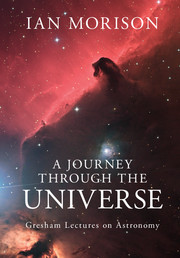Book contents
- Frontmatter
- Dedication
- Contents
- Preface
- Acknowledgements
- 1 Watchers of the skies
- 2 Our Sun
- 3 Aspects of our Solar System
- 4 The rocky planets
- 5 The hunt for Planet X
- 6 Voyages to the outer planets
- 7 Harbingers of doom
- 8 Impact!
- 9 Four hundred years of the telescope
- 10 The family of stars
- 11 Aging stars
- 12 The search for other worlds
- 13 Are we alone? The search for life beyond the Earth
- 14 Our island Universe
- 15 Wonders of the southern sky
- 16 Proving Einstein right
- 17 Black holes: no need to be afraid
- 18 It’s about time
- 19 Hubble’s heritage: the astronomer and the telescope that honours his name
- 20 The violent Universe
- 21 The invisible Universe: dark matter and dark energy
- 22 The afterglow of creation
- 23 To infinity and beyond: a view of the cosmos
- Index
- Plate section
- References
12 - The search for other worlds
Published online by Cambridge University Press: 05 October 2014
- Frontmatter
- Dedication
- Contents
- Preface
- Acknowledgements
- 1 Watchers of the skies
- 2 Our Sun
- 3 Aspects of our Solar System
- 4 The rocky planets
- 5 The hunt for Planet X
- 6 Voyages to the outer planets
- 7 Harbingers of doom
- 8 Impact!
- 9 Four hundred years of the telescope
- 10 The family of stars
- 11 Aging stars
- 12 The search for other worlds
- 13 Are we alone? The search for life beyond the Earth
- 14 Our island Universe
- 15 Wonders of the southern sky
- 16 Proving Einstein right
- 17 Black holes: no need to be afraid
- 18 It’s about time
- 19 Hubble’s heritage: the astronomer and the telescope that honours his name
- 20 The violent Universe
- 21 The invisible Universe: dark matter and dark energy
- 22 The afterglow of creation
- 23 To infinity and beyond: a view of the cosmos
- Index
- Plate section
- References
Summary
This is one of the most exciting areas of research being undertaken at the present time, with the discovery of new planets being announced on a monthly basis. This chapter will describe the techniques that are being used to discover them and then discuss their properties. Perhaps a word of warning might be in order. An obvious quest is to find planetary systems like our own which could, perhaps, contain planets that might harbour life. So far, to many astronomers’ surprise, the vast majority of solar systems found have been very unlike our own, which might lead one to the conclusion that solar systems like ours are very rare. I have even heard this point of view put forward by an eminent astrobiologist. But I do not believe one should draw this conclusion. For reasons that will become apparent, the techniques largely used to date would have found it very difficult to detect the planets of our own Solar System, so it should not be surprising that we have so far failed to find any other similar solar systems. As new techniques are used, this situation will improve, but it will be some time before we have any real idea how often solar systems like our own have arisen in the Galaxy. The story of the discovery of the first planet to orbit a sun-like star is very interesting in its own right, but, in order to appreciate its nuances, we need first to understand how this, along with many of the planets so far detected, have been discovered.
The visual detection of planets orbiting normal stars
It has been long thought that the detection of planets by direct imaging was not feasible due to the fact that the light reflected from the planet would be lost in the glare of the light from the star. However, in the infrared, stars are less bright than in the visible and the brightness difference is reduced, so making detection easier. In fact, a planetary-sized body had been detected in orbit around a brown dwarf. This was achieved using one of the 8-metre telescopes of the VLT in Chile with the use of adaptive optics to correct for atmospheric turbulence. This technique is very effective in the infrared and allows telescopes to achieve higher resolution and so can allow planets at small angular distances from their star to be seen.
- Type
- Chapter
- Information
- A Journey through the UniverseGresham Lectures on Astronomy, pp. 164 - 178Publisher: Cambridge University PressPrint publication year: 2014



